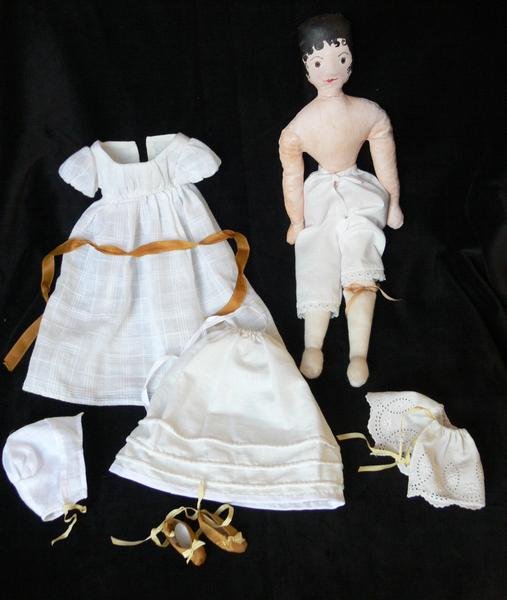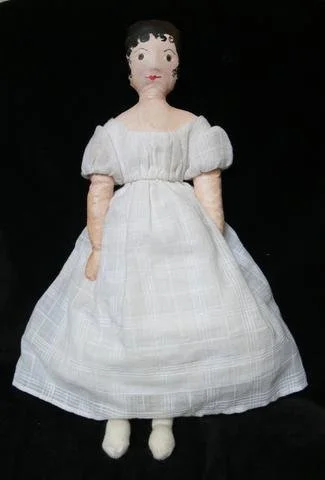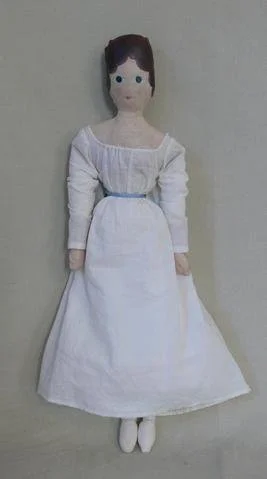The Shape of Dolls' Bodies
Dressing dolls and, it must be confessed, creating imaginary lives for them, may seem like the most frivolous of pursuits for a person who has spent her life studying textiles and their period uses. Some of is pure indulgence of one's imagination, of course, but I also find that I am able to learn about period costume in unique ways by viewing clothing history through this somewhat esoteric lens.
Dolls are remarkable miniature versions of the bodies of their times. It is easy to dress a period doll in the clothing of her era. Particularly dolls with wooden bodies, even those quite crudely made, provide unequivocal evidence of the essential body shape that lies at the core of correctly made clothes of that time period. Her body has the right shape and one is simply forced to make her garments to fit that shape. Fashionable clothes are made to satisfy an aesthetic that is partly, or sometimes wholly, unfamiliar to our modern eyes. I find that using a book like the Workwomen's Guide by a Lady (1838), with its explicit instructions for cutting out and sewing garments at home, one can create miniature versions according to the directions. If they are made correctly, they will fit the tiny doll bodies of that period.
Conversely, of course, if a wooden bodied doll has the wrong shape for a chosen time period, her clothes will never fit properly. Even if her body is made from cloth, but lacks the characteristic shape originally molded by period foundation garments, it is difficult to create a period appearance. In the latter case, the doll's dressmaker is left clueless and can easily neglect important details.
For instance, during the mid-20th century, several authors created volumes dedicated to making and dressing dolls in period clothing. The best known is probably The DOLL BOOK, Estelle Ansley Worrell (1966). While it contains quite a bit of accurate information about period costume, the patterns for the cloth doll bodies are all the same for the different time periods (17th - early 20th century). Consequently, the garments were all generalized to fit that body shape and end up looking more like the costumes of the same era that arose out of US Bicentennial celebration fervor. In other words, while accurate in some details, they simply lacked the fundamental shape peculiar to the fashions of each time. Those full sized garments actually needed to have 20th century body shapes as their basis, so that real modern people could wear them in 1976. The dolls could have been vastly improved if their bodies, and consequently their clothing, were shaped accurately to historical fashion.
I have made a number of these cloth dolls, although, after the first one, I altered the body shape for 18th and 19th century to reflect the fashion of those times. That helped, but then the garments from that book did not fit those dolls with the refined shapes.
Here is a photo showing a doll named Lucy, made by me, with my altered early 19th century body shape and a collection of garments: gown and slippers made from Worrell's book and other items from the Workwoman's Guide & diverse period sources. The sore thumb is the gown. It is unshaped in the bodice, as if for a young girl. It gives Lucy a shapeless, rather dowdy appearance -- the last thing desired by the women who donned thin, muslin fashions of the early 19th century!
This contrasts dramatically with the appearance of another doll I made from the same cloth patterns (using the modified early 19th century body shape). Instead of following the same book for clothing, her gown was fashioned using a publication from the Royal Ontario Museum, that includes reduced size patterns for several dresses in their collection. Those patterns were created from unaltered period garments. The muslin gown is unlined and characteristically shaped. The next illustration shows the second doll, Jane, in that miniature replica of the period gown.
The way it sits on her shoulders brings to mind paintings of the time, the sash ties below a loose short train, and the sleeves fit in the loose, casual manner intended. In other words, she looks more like a person of 1800 or so.



